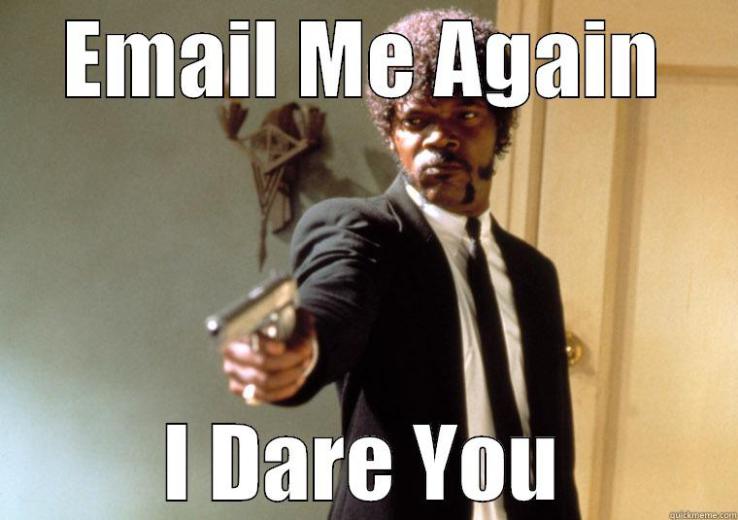The single most useful thing if you want to bend the ear of any CEO (or executive, or mailroom boy, for that matter) is to be where they are. Assuming that doesn’t mean breaking into their house and waiting for them to come home (disclaimer: we do NOT recommend this course of action), a great way to do this is to attend the same conferences or events as they do.
Our next post will centre on preparing for conferences and trade shows itself, while this post focusses on how to secure a meeting once you’ve decided to attend an event your target will be at.
How to secure a meeting
We’ll assume you’ve done the background research to be as sure as possible that your pitch will strike a chord with the person you’re trying to meet. No matter what you do, selling the right product to the wrong person is likely to be a waste of everyone’s time.
If you don’t have your pitch and proposition nailed, this post might be a few steps ahead for you, since the assumption is that some market research and validation has already been done. We’ll also assume you don’t have a warm introduction into that person, since that’s the best way of all to get some ear-time.
Conferences will generally have some indication of what companies will be attending and in most cases names of attendees will be made available – for example, Mobile World Congress (MWC) has a particularly useful search & browse networking interface. You usually won’t have access to direct emails, so the main thing to do once you know the individuals you want to meet is to find their email address. LinkedIn InMails work some of the time but in our experience there’s still nothing to beat having an email address. Keep in mind that less can be more in terms of the number of emails you send out – better to research 50 individuals/companies thoroughly and send tailored emails than sending the same generic message to 500 people. Like dogs and fear, people have developed an acute sense for templated emails.
We won’t go into an exhaustive list of ways to get emails, just a couple of the more effective ones here:
- The star of the show these days is a tool called Rapportive, which helps you to work out what a person’s email address is, so get that first.
- You can use Rapportive in conjunction with GMail to guess a person’s email by following the instructions at http://www.businessinsider.com/rapportive-tool-for-finding-emails-and-contacts-2013-8
- If Rapportive doesn’t work (some people aren’t on LinkedIn and other social sites, shock horror!), you can always try searching the Web – certain job functions result in email addresses being published online. If you can find a Slideshare presentation by the person you’re targeting, they will frequently include an email at the end.
- It can also be worth googling [“@x.com” “firstname lastname”] – it works more often than you might think!
As mentioned, getting the email address of a person in the right role working at the right company is most of the battle. Your email must strike the right notes, present your product crisply so the value is obvious and your product must truly have value. This post is not intended to help with crafting the perfect pitch but depending on feedback we might write a separate post on that topic. As with the current topic, we’ve done it howlingly poorly and supremely persuasively. Also read these posts by Mark Suster and Mattan Giffel for tips on email etiquette and how to get busy people to read you emails.

Image credit: Quickmeme.com
Wait … is that ethical?
It’s valid enough to say that if someone doesn’t have their email address plastered all over the Web, they may not want unsolicited mail (aka spam) from you or anyone else. Unfortunately the world isn’t that black and white, so you have to be considerate in deciding how to approach cold-emailing. People go to events to meet relevant people so as long as you’ve given plenty of thought to making your proposition truly relevant to those you’re trying to reach, you shouldn’t need to lose any sleep.
In terms of repeat emails / following up, I generally follow the “do unto others as you would have them do unto you” approach to cold-emailing first proposed by Jesus Christ. My inbox is fairly lively in terms of spam and there’s lots of different kinds. There’s the completely untargeted kind offering me viagra and teeth whitening services (how did they know?), the sort-of relevant but not right now and probably never, and the remainder can be anything from “wow, gotta reply immediately” to “I’m not in a murderous rage that you sent this but I’m going to ignore it”.
My inner deal with the more relevant kind of spammers (unsolicited but in the right industry, with a pitch that could be relevant) is it’s fine to send it but I reserve the right to ignore you for all eternity. Now and then these folks will repeat email you and depending on the schedule/tone it can elicit very different reactions. Some use the “presumed close” and without ever having spoken to me refer to previous conversations we’ve had and ask what time suits for a call. Some increase in frequency thinking you just haven’t seen their message and flooding your inbox will dramatically increase your chances of buying their foreign exchange banking services (my most recent example). I delete most of them, and that’s ok by me, as long as the repeat mails aren’t close together and the tone doesn’t becoming irritated or pestering i’m not going to hate you forever. And I assume the same from people I email.
You’re Emailing Humans. Be human.
I make individual decisions based on who I’m emailing about whether and when to repeat email, and my repeat emails always have new text and ideally a new subject line. If you’re emailing the CEO of AmazingTech Inc. about your cloud-based Big Data Analytics solution for Flappy Bird clones, and in their most recent keynote they mentioned that their company will fail unless they can get a handle on their Flappy Bird clone data, it’s probably ok to try more than once.
Imagine the person at the end of the email and that usually makes it easier to work out if it’s worth sending. Better still, imagine you’re the receiver – if your first, second or third email would have annoyed you (shelving the inevitable “but my product’s great, of course i’d love to receive an email about it!” bias) then don’t send it. If the person you’re emailing were sitting in front of you and you had to justify your emails would you be able to do it? Please don’t use Rebump – it’s evil – and try not to be like this guy.
Above all, be human. Conversational emails are always better (in my experience) than canned, marketing-speak missives, and since this is a cold-emailing situation, you need to connect with the human at the other end of the Internet pipes. Engage with the human, not the business proposal.
The Secret Sauce
As with many things in life, the secret to effectively making contact with people is preparation. One thing that’s certain is that you’ll make mistakes, but as Albert Einstein said “anyone who has not made a mistake has not tried anything new”. Follow the steps below, always engage at a human level, and do what feels right for you and you’ll hopefully get those golden meetings.
-
Research the people you’d like to meet and tailor your pitch accordingly.
-
Make sure your pitch is genuinely interesting to these people or you’re wasting everyone’s time.
-
Being “politely persistent” – always be considerate, imagine the person you’re trying to get in touch with and tailor your message and frequency of contact accordingly. There’s a fine line between persistence and harassment.
-
Speak as a human and to a human. People engage with and buy from people, so the more personality you can bring to your cold-emails, the better. I’m not saying you should act like you are best buddies with the recipient, since that comes off as insincere but keep in mind that it’s a person reading your email and you won’t go far wrong.
The above is our own approach for getting meetings with people, and as you can tell it’s a work in progress. I’d love to hear from any readers in the comments about additional tips you might have.


